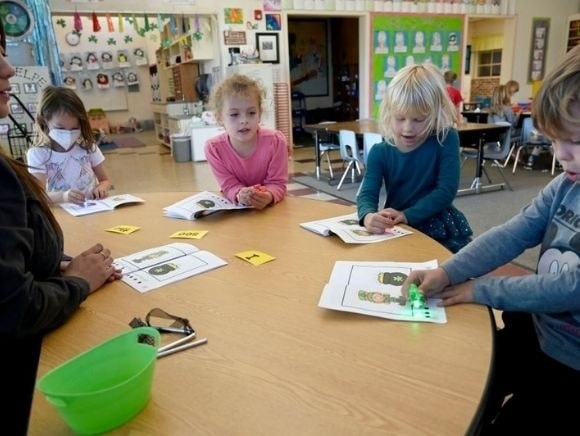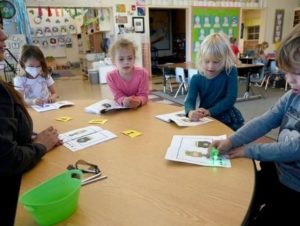
(Photo by Brittany Murray/MediaNews Group/Long Beach Press-Telegram via Getty Images)
A relatively new teaching methodology swept the education world in the past few years. Known as Social-Emotional Learning (SEL), it has introduced novel concepts designed to revolutionize how children learn in K-12 classrooms. However, amid the debate over Critical Race Theory (CRT) and other far-leftist ideas being presented to young students, some have expressed reservations and outright criticism of the practice.
SEL is not related to the teaching of subjects like mathematics, reading, history, and more. Rather, it helps students relate to the world around them and interact more productively with others. In essence, assisting children to develop emotional intelligence.
School districts across the country have embraced SEL, spending millions of dollars to incorporate it into their classrooms. The Seattle Times reported:
“Nationwide, school and district spending on SEL grew roughly 45 percent between November 2019 and April 2021, according to a report by Tyton Partners, an education consulting and investment firm. The increase was driven by concerns about student well-being amid a global pandemic and a national reckoning on race, and enabled by a massive infusion of federal recovery funds.”
 The story also noted that about a third of local educational agencies plan to allocate some of their federal relief money to SEL.
The story also noted that about a third of local educational agencies plan to allocate some of their federal relief money to SEL.
So, what exactly is Social Emotional Learning?
According to National University, SEL “is a methodology that helps students of all ages to better comprehend their emotions, to feel those emotions fully, and demonstrate empathy for others.” It guides students to “make positive responsible decisions; create frameworks to achieve their goals, and build positive relationships with others.”
The Collaborative for Academic, Social, and Emotional Learning (CASEL), an organization that assists students and educators work toward positive outcomes, identified five core competencies addressed in SEL:
- “Self-awareness – To recognize your emotions and how they impact your behavior; acknowledging your strengths and weaknesses to better gain confidence in your abilities.
- “Self-management – To take control and ownership of your thoughts, emotions, and actions in various situations, as well as setting and working toward goals.
- “Social awareness – The ability to put yourself in the shoes of another person who may be from a different background or culture from the one you grew up with. To act with empathy and in an ethical manner within your home, school, and community.
- “Relationship skills – The ability to build and maintain healthy relationships with people from a diverse range of backgrounds. This competency focuses on listening to and being able to communicate with others, peacefully resolving conflict, and knowing when to ask for or offer help.
- “Making responsible decisions – Choosing how to act or respond to a situation based on learned behaviors such as ethics, safety, weighing consequences and the well-being of others, as well as yourself.”
SEL is not an individual subject that is taught as a class. Rather, it is “woven into the fabric of a school’s curriculum,” according to National University, which also explained that “[b]y fostering a sense of empathy, self-awareness, and feelings of safety and inclusiveness in the classroom, SEL can have a positive impact that lasts a lifetime.”
There are various ways to apply SEL. In some cases, educators might designate a formal portion of class time to teach its concepts. This typically occurs during homeroom. Teachers can have students journal their thoughts and feelings about an SEL lesson or even partner with other students on an assignment.

(Photo by Brittany Murray/MediaNews Group/Long Beach Press-Telegram via Getty Images)
Another method involves infusing SEL into subjects like math, history, reading, and more. For example, a teacher could assign a group project in which students “self-delegate roles to work together for the good of the group, role playing as historical figures to understand the rationale behind a person’s actions,” or have students “conduct formal interviews with one another to take a pulse-check on current events,” according to National University.
Educators might collaborate with pupils to track their progress, set goals, and help them feel a sense of accomplishment when they meet their objectives.
SEL is believed to provide substantial benefits to students when it comes to academic achievement, positive behaviors, and self-awareness. For example, one study showed that children who participated in SEL programs showed an 11 percentile increase in their grades. They also demonstrated progress in helping their peers deal with stress, solve problems, and avoid engaging in harmful activities.
While SEL appears to benefit the students who are involved in its programs, some are not so keen on the methodology. Parents, teachers, and commentators have pointed out that, in many instances, the programs are being used to present radical leftist ideas in the classroom. Indeed, with the furor over CRT and teachings on gender identity, several states have passed laws intended to curtail problematic pedagogy in K-12 schools. The backlash has applied pressure to districts and school boards to ensure educators are not indoctrinating children. Many have alleged that SEL is a way to continue covertly promoting these ideas without parents knowing.
Donique Rolle, a teacher in Orlando, FL, told Liberty Nation:
“Social-Emotional Learning is ok in theory. It’s designed to teach students self-awareness and self-management skills, build social awareness, and be responsible decision-makers. However, in practice, SEL ranges from teaching students to ‘say no to drugs’ to lessons on gender identity and sexual orientation. Teachers are not experts in any of these areas, nor do we have the proper training to make SEL effective.”
Others have echoed Rolle’s sentiments, acknowledging that when SEL was first introduced, it was not being used to introduce leftist ideology. However, over time, it appears to have been altered to serve this purpose.
Lisa Logan, a Utah parent, made headlines last year when she and another parent discovered concepts related to CRT being infused into the eighth-grade curriculum in their children’s school district. She told Liberty Nation that the methodology is a “Trojan horse” of sorts, designed to influence students into accepting leftist ideology. She said:
“Social emotional learning, which once was about children recognizing emotions and figuring out how to manage them in individual and group settings, is now a Trojan horse for manipulating students to accept and advocate for certain political ideologies. This new branding of social emotional learning, Transformative SEL, uses topics like bullying, identity and empathy to teach Critical Race Theory tenets, queer theory, comprehensive sexuality education and social justice activism.”

When going through the curriculum last year, Logan found that the Second Step SEL program used in her child’s school discussed “power and privilege” as one of the three primary factors behind bullying. It also sought to teach kids to be social justice activists and touted leftist ideas on sexuality.
“Parents are unaware that concepts like Critical Race Theory and Comprehensive Sex Education are being taught under the guise of Social Emotional Learning programs like Second Step,” Logan said in a press release, “and that has to change.”
As the conflict over education continues to rage, parents are becoming even more concerned about what their children are learning in public schools. This hot-button issue will likely be a factor in the upcoming congressional elections. However, regardless of how those races shake out, it is clear this debate will not be over any time soon.
Remember to check out the web’s best conservative news aggregator
Whatfinger.com — the #1 Alternative to the Drudge

